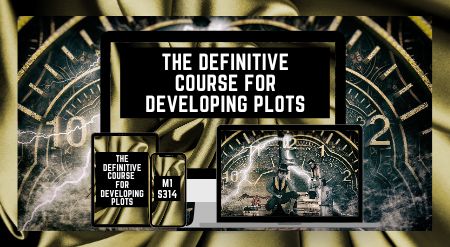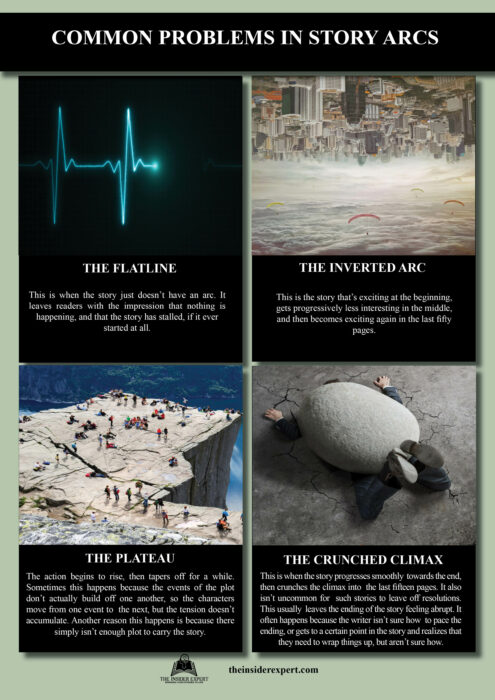SAMPLING FROM: The Definitive Course for Developing PLOTS

This is a sampling of the content in The Definitive Course for Developing PLOTS (M1-S314)
TOPIC: How to identify your STORY ARC Problems
Before an author can create a compelling narrative, they really need to grasp what a plot is all about. The plot of a story is basically the author’s roadmap for how the events will play out as the story progresses. The author uses a narrative plot as a guide, highlighting the key events that shape the story.
In this lesson, we’re going to chat about what a story arc is and some common challenges that authors run into when creating them.
From First Page to Final Word: Strengthening the Story Arc in Your Writing
For fiction writers, a story arc ensures emotional satisfaction and transformation;
For non-fiction writers, it provides structure, flow, and clarity.
Identifying and fixing arc problems is what separates a loose collection of words from a work that truly resonates.
For Fiction Writers
A story arc is the backbone of your novel. It gives shape to the journey from beginning to end, carrying your characters and readers through a process of change, conflict, and resolution. Without an arc, a story feels flat, aimless, or unsatisfying. A strong arc creates emotional investment, ensuring the reader experiences rising tension, pivotal turning points, and a conclusion that feels both inevitable and earned.
-
Ask yourself if the story escalates naturally, or whether events feel random.
-
Consider whether your protagonist changes across the course of the book; if not, the arc may be stalling.
-
Look for “sagging” sections in the middle where tension fades.
-
Test the ending: does it resolve the central conflict and reward the reader’s attention?
-
Seek feedback: if readers say “it drags,” “it’s confusing,” or “the ending didn’t satisfy,” these point directly to arc weaknesses.
- Weak beginnings – A slow or unclear opening that fails to hook.
- Flat middles – Too much filler or lack of rising conflict.
- Rushed endings – A climax that feels sudden or unearned.
- Unchanged protagonist – A character who goes through events without transformation.
- Uneven pacing – Moments of tension scattered without rhythm.
- Conflict mismatch – The arc promises one type of resolution but delivers another.
- Excessive subplots – Side stories that dilute the main arc.
For Non-Fiction Writers
Even in non-fiction, story arcs matter because readers crave narrative shape. Whether you are writing memoir, biography, history, or a how-to guide, an arc turns information into a journey. It ensures the reader sees progression—growth, discovery, or resolution—rather than a pile of disconnected facts. A strong arc builds authority and keeps readers engaged, helping them follow your argument or your subject’s life with clarity and momentum.
- Check if your material feels like a sequence of episodes rather than a journey.
- Ask whether each chapter moves the reader closer to understanding the central theme.
- Look for sections overloaded with information that interrupt flow.
- Test whether the conclusion ties back to your opening promise or question.
- Seek reader feedback: if they say “I got lost,” or “it felt repetitive,” the arc may be unclear.
-
Overloaded beginnings – Starting with too much background or theory before engaging the reader.
-
Meandering middles – Repetition of points without moving the argument forward.
-
Abrupt endings – Finishing without answering the book’s guiding question.
-
Disjointed chapters – Each section useful but not building towards a whole.
-
Imbalanced focus – Dwelling too long on minor points and skimming crucial ones.
-
Lack of progression – A memoir or case study that does not show development or insight.
-
Disconnected evidence – Facts or stories that don’t clearly relate to the central message.
Questions to Ask Yourself that May Help

Questions for Fiction Writers — Identifying Story Arc Problems
Beginnings are the opening that hooks the reader and sets up the central conflict.
- Does my opening scene hook the reader immediately?
- Is the inciting incident clear and compelling?
- Does the beginning set up the central conflict?
- Have I introduced the protagonist’s goal early enough?
- Do I spend too long on backstory before the plot starts?
Middles refers to the rising tension where characters are tested and the story deepens.
- Does the middle section maintain rising tension?
- Are there stretches where the action stalls?
- Do subplots strengthen the main arc or distract from it?
- Is there a clear midpoint that shifts the story?
- Do the stakes increase as the story progresses?
Endings refer to the resolution that provides a satisfying and logical conclusion.
- Does the climax feel earned rather than forced?
- Have I resolved the central conflict satisfactorily?
- Is the ending rushed compared with the rest of the book?
- Does the protagonist change by the end?
- Does the resolution tie back to the beginning?
Character Arcs is the personal growth or transformation of characters across the story.
-
Is the protagonist’s transformation believable?
-
Do characters remain static without growth?
-
Do supporting characters serve the protagonist’s arc?
-
Does anyone act “out of character” to serve the plot?
-
Do emotional shifts feel too sudden or underdeveloped?
Pacing & Flow is the rhythm of scenes that keeps the narrative moving without drag or rush.
-
Do I have long, dragging chapters that slow momentum?
-
Do key events happen too quickly without build-up?
-
Does tension rise and fall in the right places?
-
Is there a balance between action and reflection?
-
Do I drop tension completely before the climax?
Conflict & Stakes is the pressures and risks that drive characters to act and keep readers invested.
-
Is the main conflict strong enough to sustain the arc?
-
Do smaller conflicts feed into a larger one?
-
Are the stakes too low for readers to care?
-
Are obstacles believable or contrived?
-
Is the antagonist’s role clear in shaping the arc?
Structure is the shape of the story, ensuring events build logically and cohesively.
-
Does my story follow a recognisable arc (three acts, a hero’s journey, etc.)?
-
Have I accidentally created a flat or circular structure?
-
Do turning points arrive too late or too early?
-
Do scenes build logically from one to another?
-
Is there a sense of progression rather than repetition?
Thematic cohesion is the way the story’s deeper meaning is woven consistently throughout.
-
Does the story arc reflect the themes I want to explore?
-
Have I wandered away from my main theme in the middle?
-
Does the climax embody the story’s moral or central idea?
-
Is the protagonist’s journey tied to the bigger message?
-
Do readers finish with a clear sense of “what it was all about”?
Reader Engagement is how effectively the story grips and sustains the reader’s attention.
-
Would readers guess the ending too soon?
-
Would they feel cheated by the resolution?
-
Do readers remain emotionally invested across the arc?
-
Does suspense build naturally or feel forced?
-
Would readers say the story “sags” anywhere?
Self-Reflection is the writer’s own awareness of indulgence, imbalance, or missed opportunities in the draft.
-
Am I trying to do too much in one story arc?
-
Have I included filler to meet the word count?
-
Am I rushing to the end because I’ve lost my momentum?
-
Do I personally feel satisfied by the story’s shape?
-
Would I enjoy reading this arc if it were not my own?
Questions for Non-Fiction Writers — Identifying Story Arc Problems
Beginnings is the introduction that frames the subject and captures attention.
- Does my introduction clearly state the purpose of the book?
- Do I grab attention with a strong hook or anecdote?
- Have I overloaded the start with background before engaging the reader?
- Does the opening set up a clear question or theme?
- Do readers understand what journey they are about to take?
Middles refers to the process of developing ideas, evidence, or narratives that build momentum.
-
Does each chapter build logically on the one before?
-
Is there a clear sense of progression rather than repetition?
-
Do I lose momentum with too many digressions?
-
Is there a strong turning point or central revelation?
-
Does the middle connect clearly to both the beginning and end?
Endings – The conclusion that ties together the argument and leaves readers with clarity.
-
Does the conclusion answer the question I posed at the start?
-
Do I tie threads together or leave ideas hanging?
-
Is the ending abrupt or underdeveloped?
-
Does the conclusion feel too drawn out?
-
Do readers walk away with clarity, insight, or action steps?
Case studies and examples provide illustrative stories or data that bring abstract points to life.
-
Do the examples reinforce the main arc?
-
Have I repeated examples unnecessarily?
-
Do case studies appear at the right time in the narrative?
-
Are stories balanced with analysis, not dominating it?
-
Do I link each example back to my central argument?
Argument & Evidence – The logical progression of claims supported by credible proof.
-
Does the argument build layer by layer?
-
Have I introduced evidence too late for impact?
-
Do I frontload too much theory before applying it?
-
Does my evidence flow logically or feel scattered?
-
Do I maintain balance between detail and pace?
Pacing & Flow – The balance of explanation, example, and analysis to maintain readability.
-
Are some sections overlong and others too short?
-
Do I lose readers in overly technical passages?
-
Have I avoided repeating the same point in multiple chapters?
-
Do transitions between chapters feel natural?
-
Is there enough variety in pacing to keep readers engaged?
Structure is the overall organisation that ensures ideas build into a coherent whole.
-
Does my book follow a recognisable arc (chronological, thematic, or problem-solution)?
-
Have I drifted from my structure midway?
-
Do some chapters feel irrelevant to the main journey?
-
Is the central theme present throughout?
-
Does the book feel like a collection of essays rather than a unified arc?
Reader Engagement refers to the techniques that keep readers interested, informed, and motivated to continue.
-
Am I keeping the reader emotionally and intellectually involved?
-
Would the reader get lost or overwhelmed mid-way?
-
Do I give them reasons to keep turning pages?
-
Does each section deliver value before moving on?
-
Do readers feel guided, not lectured?
Thematic Cohesion – The consistency of focus so that all sections reinforce the main message.
-
Is my message consistent from start to finish?
-
Do side arguments distract from the main point?
-
Does the conclusion reinforce the opening premise?
-
Are themes presented too vaguely to resonate?
-
Does the book deliver on the promise of its title?
Self-Reflection – The writer’s evaluation of clarity, concision, and whether the book truly fulfils its purpose.
-
Am I including material simply because I researched it?
-
Have I trimmed the manuscript to focus on what matters?
-
Am I afraid of cutting favourite passages, even if they weaken the flow?
-
Does the book as a whole have a clear journey?
-
Would I, as a reader, feel guided, satisfied, and enlightened by this arc?
PDF Workbook Instructions

Download your PDF handout and save it to a folder you have created on your computer specifically for saving your ideas, so you can refer to it again and again.
Open the downloaded PDF handout in a PDF viewer
Save your files in your handout’s ideas computer folder so you can refer to them again and again.
Want More
Are you interested in learning more after giving the sampling a shot? Are you interested in picking up something new and figuring out how to connect events in a way that keeps your readers engaged?

The Definitive Course for Developing Plots (M1-S314)
If you’re after a more focused learning experience, this option could be just what you need. There are a bunch of different ways to think about plot structures. But you know, it’s good to keep in mind that plot and structure are kind of like gravity; you can choose to go with the flow or push back against them.
In this course, you’ll discover how various plots come together to connect the events in your storyline. You’ll get to explore various story arcs and plot structure elements that really tap into the reader’s emotions. You’ll get 8 lessons to learn at your pace, and you can go over the material as many times as you want to really grasp the concepts.
This course comes with some really great handbooks, including examples of a power plot, a plot and story guide, and tips on how to choose the best location for your plot. You’ll also find out what plots are all about and how to identify the various plot types and their structural elements.
